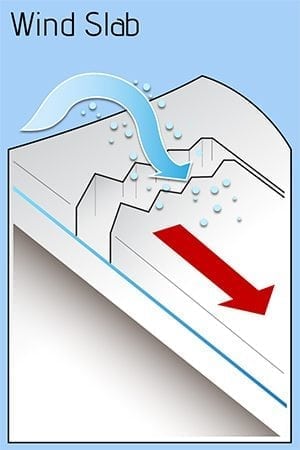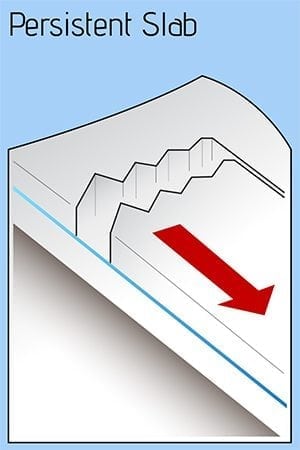Valdez
Above 3,000ftConsiderable
1,500 to 3,000ftConsiderable
Below 1,500ftModerate
The Avy Rose shows the forecasted danger by elevation and aspect. It adds more detail about where you are likely to find the dangers mentioned in the forecast. The inner circle shows upper elevations (mountain top), the second circle is middle elevations, and the outer circle represents lower elevations. Think of the Rose as a birds-eye view of a mountain, looking down from above. The rose allows our forecasters to visually show you which parts of the mountain they are most concerned about.
Degrees of Avalanche Danger
Avalanche Problems
Problem 1
Strong north winds have redistributed the new snow that fell on Monday and Tuesday into fresh wind slabs. Reactive wind slabs were found 1-3 feet deep on test slopes on 12/9, with wide propagations observed relative to slope size. Flagging at high elevations was seen, and indicates that wind slabs are continuing to build in some locations. The possibility for human triggered avalanche 1-3 feet deep remains likely today in specific locations with natural avalanches possible.
Wind slabs are expected to remain reactive longer than what is typical due to poor bonding at the hard bed surface beneath. Wind slab depths will be in the 1-3 foot range. Places to watch out for will be the lee side of high elevation ridge lines (SE-NW),cross loaded gullies and the lee side of terrain features. Pillowed snow surfaces, freshly formed cornices and shooting cracks are all indicators of a freshly loaded slope. Test slopes can be a good way to asses wind slab sensitivity.
Pay attention to wind distribution patterns and plan your route accordingly. Good stability has been found on windward aspects.
Thin (weak) snowpacks can not handle the sudden changes that a strong (thick) midwinter snowpack can. As snow and weather conditions change expect to encounter areas of unstable snow.
Likelihood:
- Almost Certain
- Very Likely
- Likely
- Possible
- Unlikely
Size:
- Historic
- Very Large
- Large
- Small
Trend
- Increasing
- Steady
- Decreasing
Problem 2
There are multiple rain crusts from October that are faceting in the mid and lower snowpack. Late November winds created very strong snow above these layers making it difficult for a person or machine to affect. Newly formed wind slabs are adding stress to these layers. At this point, it is unlikely that we have received enough new snow/load to overcome the strong bridging affect of the wind damaged snow from late November that is near the surface. We can not rule out that smaller storm snow or wind slab avalanches could have enough force to step down to these deeper layers.
Affecting this avalanche problem is currently unlikely, but will likely become a problem on Sunday as we are forecasted to receive some significant snow.
There is a higher possibility of affecting these layers in the continental zone where a more faceted snowpack exists.
Likelihood:
- Almost Certain
- Very Likely
- Likely
- Possible
- Unlikely
Size:
- Historic
- Very Large
- Large
- Small
Trend
- Increasing
- Steady
- Decreasing
Avalanche Activity
11/14- Debris from a D3 natural avalanche at snow slide gulch ended 100 vertical feet above the Lowe river.
Large avalanches (D2-2.5)also occurred in multiple other locations including Berlin Wall, Catchers Mitt, South Three Pigs and Billy Mitchell. The activity extends beyond this list, and mostly occurred during the peak of warming and precipitation on 11/13.
Multiple natural D1-1.5 avalanches were observed on multiple aspects at low elevation. No step downs noted.
12/1- 2 D2.5 natural avalanches were noted on Three Pigs (Beaver slide, Pig Leg). Pig leg ran into the top 1/3 of the fan and Beaver Slide stopped near the end of its track. These both likely occurred during the outflow wind event 11/26-11/29.

D2 natural wind slab was observed on 40.5 mile peak on a west aspect ~3000′. Crown depth range estimated 1-2 feet and 200′ long

12/9- Several D2 natural wind slab avalanches were observed on S-W aspects at mid elevation in the intermountain region. Crowns appeared to be 1-3 feet deep. Catchers Mitt and Gully 1 were among the spots affected.
Weather
Check out our updated weather tab! A collection of local weather stations are available for viewing with graphs and tabular data included.
NWS Watches and warnings
None
NWS Point forecast for Thompson Pass
Date Saturday 12/10/22 Sunday 12/11/22 Time (LT) 06 12 18 00 06 12 18 00 06 Cloud Cover CL FW OV OV OV OV OV OV OV Cloud Cover (%) 0 25 70 80 90 100 100 100 100 Temperature 8 9 10 7 10 14 18 20 23 Max/Min Temp 13 6 19 17 Wind Dir NE NE S S SE SE SE E E Wind (mph) 23 13 4 5 8 11 10 14 12 Wind Gust (mph) 37 25 Precip Prob (%) 0 0 0 20 60 90 80 100 100 Precip Type S S S S S S 12 Hour QPF 0.00 0.02 0.23 0.90 12 Hour Snow 0.0 0.0 4.0 13.3 Snow Level (kft) 0.0 0.0 0.0 0.0 0.0 0.0 0.0 0.0 0.5
Click on link below for Thompson Pass weather history graph:

| Date:
12/10 |
24 hr snow | HN24W* | High temp | Low temp | 72 hour SWE* | December snowfall | Seasonal snowfall | Snowpack Depth |
| Valdez | 0 | 0 | 33 | 24 | 0 | 10 | 34 | 19 |
| Thompson pass | 0 | 0 | 15 | 6 | 0 | 8 | 109 | 26 |
| 46 mile | 0 | 0 | 21 | -7 | 0 | 2 | 2** | 16 |
*HN24W- 24 hour Snow water equivalent in inches
*SWE– Snow water equivalent
**46 mile seasonal snowfall total begins December 1st.
Additional Information
Our snow season began with above average precipitation and temperatures. Beginning in September, snow lines generally hung around 4500′ until 10/12. At that point our area received the first snow down to sea level with 12-16 inches on the north side of Thompson Pass.
On 10/15 wet conditions continued with the freezing line rising to 5000′ or higher. As skies finally cleared on 10/22 we were left with a thin rain saturated snowpack capped by a stout rain crust up to 4500′. Above 4500′ much deeper snowpacks existed due to significant early season snowfall at upper elevations.
Dry and cold conditions along with moderate outflow winds finished out the month of October.
On 11/1 precipitation returned with 18 inches of snow and ~1″ of SWE on Thompson Pass. This new snow was initially reactive with several natural D2 avalanches reported on Thompson Pass. These slides were running on a firm bed surface consisting of old rain crusts and old wind slabs from October.
On 11/4 a strong north wind event kicked up with 65 mph+ winds on Thompson Pass. Our snowpack received significant damage as already thin snow below 4500′ was stripped down to old wind slabs, rain crusts and the ground.
Precipitation returned on 11/8 and became heavy on 11/11. Storm totals of around 50 inches were recorded at Thompson Pass DOT between 11/8-11/13. Snow lines rose to ~3000′ near the tail end of the storm with heavy rain occurring in low lying areas.
Skies cleared on 11/14 through 11/18 with a strong temperature inversion setting up. Valley temperatures north of Thompson Pass fell to 0° F with above freezing temperatures existing above 4000 feet. Valdez temps remained mild. This weather allowed for widespread surface hoar up to 1 cm to develop in low lying areas.
Precipitation returned on 11/19, with incremental snowfall on Thompson Pass and areas north. The Valdez area received rain during this period. 12 inches have been recorded at TP DOT between 11/9-11/23.
11/26-11/29- Strong outflow (N) wind event. Many areas below 3000′ were stripped to the 11/13 rain crust, destroying the 11/19 BSH layer. Widespread very hard snow surfaces were the result.
Precipitation returned to our area on 12/5, with higher accumulation amounts near the coast. As storms cleared out on 12/7, they were directly followed by another round of strong north winds.
Announcements
The avalanche hazard remains Considerable above 1500′. Strong north winds have moved the new snow from Monday and Tuesday into fresh windslabs creating dangerous avalanche conditions. Human triggered avalanches will be likely in specific locations 1-3 feet in depth and natural avalanches are possible. Watch for signs of instability such as shooting cracks, collapsing and recent natural avalanche activity. Pay attention to where the wind has deposited wind slabs and plan your route accordingly to avoid these.
Posted by Gareth Brown 12/10 8:00am.
For a description of current avalanche problems, weather information, season history and more click the (+ full forecast) button. Avalanche forecasts will be issued Wednesday-Sunday.

